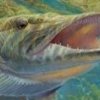I am fairly new at wood lure building also. I already had a bandsaw so shaping lures was easier. I wish the sanding and finishing wasn't so tedious, but that is very important to getting a good looking lure. I also have been hand painting lures, but just purchased an airbrush. My opinion is I think you need an airbrush to get a better paint job. Hand painting has to many straight lines between colors and not as even of a coat. I think you can blend colors better with an airbrush. Water based paints are easier to work with. You want a good wood sealer before you prime or paint. I have tried D2T as a topcoat, but thought it was to brittle for pike/musky lures. I think D2T works great for and extra seal coat. It also has some build so it hides some sanding imperfections before you prime and paint. You can sand it after is cures so primer/paint adheres. I personally like Etex for a topcoat, but have not tried all of them yet. It takes a few coats but it is not as brittle and more flexible over wood. I am experimenting with counterweights. But what I have learned so far is putting the weight towards the back will make it cast farther with less dive. Putting the weight towards the front will cast shorter with more dive. Also where you put the weight changes the action of the lure. I think alot of that is trial and error. Lips are also trial and error. What I have learned is the more horizontal the lip is the deeper the lure drives, but the shape of the lip and how bouyant your lure is also plays a role in the action. LIke I said earlier, I am fairly new at lure building also, but I hope this helps. Really when you look at the whole picture, it is all alot of trial and error.
CLM






